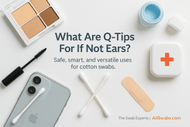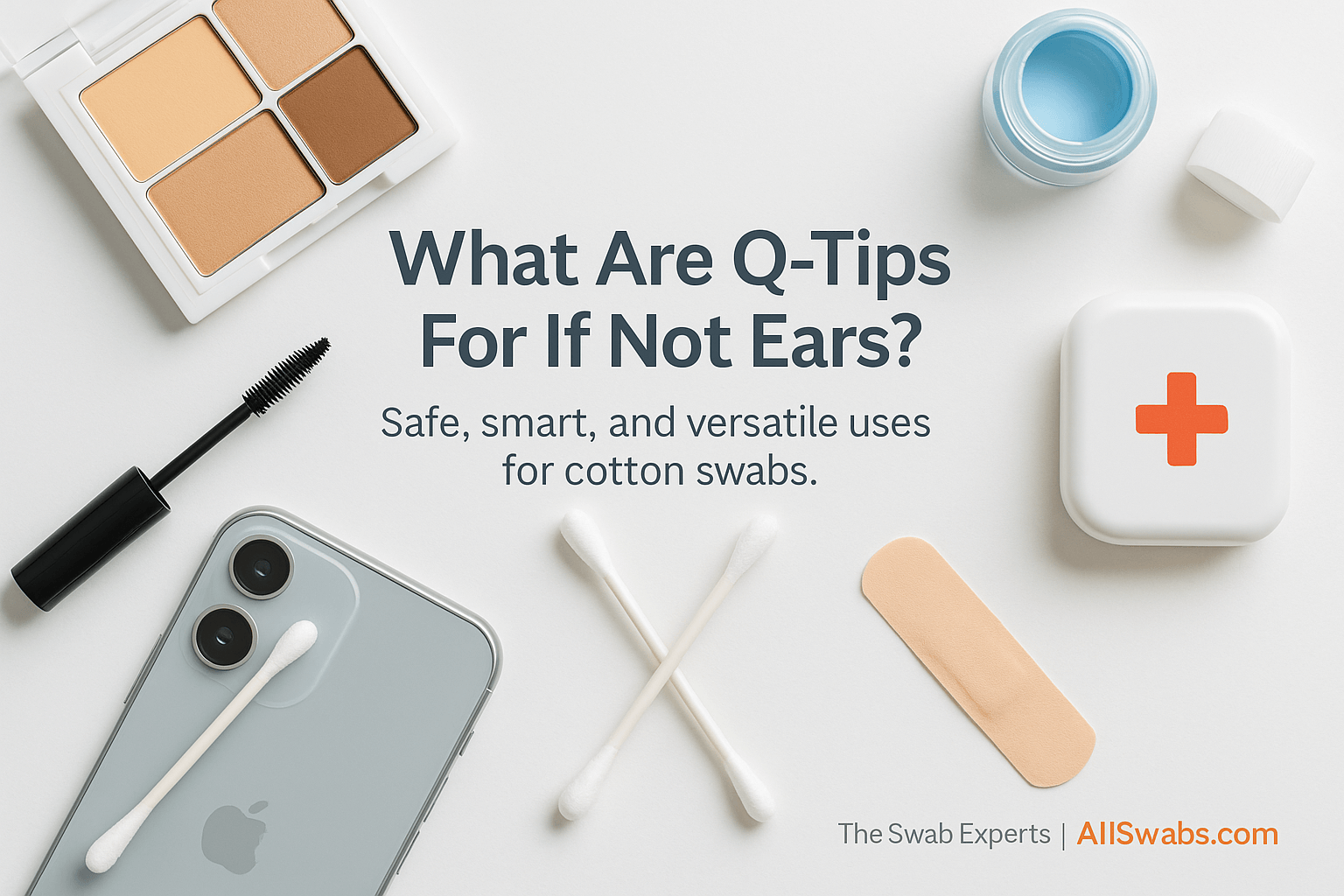What Are Q-Tips For If Not Ears?
Published by AllSwabs.com on Oct 08, 2025
What Are Q-Tips For (If Not Ears)?
If you’ve ever wondered “what are Q-tips for if not ears”, you’re not alone. The truth is, cotton swabs aren’t designed to go inside your ear canal—and leading medical organizations warn against it. But that doesn’t make them useless. In fact, cotton swabs shine in dozens of safe, precise, and practical tasks—from beauty touch-ups to delicate electronics care, first aid, crafting, and even professional lab work. This guide explains why ear swabbing is risky, then shows you 10+ smarter ways to use cotton swabs, plus when to upgrade to professional-grade alternatives for the best results.
Why You Shouldn’t Use Q-Tips in Your Ears
Ears are largely self-cleaning. When you insert a cotton swab into the ear canal, you risk pushing wax deeper (impaction), scratching delicate skin, or even perforating the eardrum. That’s why ENT specialists and major medical institutions caution against placing anything smaller than your elbow in the ear canal. It’s okay to use a cotton swab to gently clean the outer ear, but leave deeper wax removal to healthcare professionals, especially if you’ve had ear surgery, have a suspected perforation, or experience pain, drainage, or hearing changes.
10+ Safe, Smart, and Creative Uses for Q-Tips
If you came here asking “what are Q-tips for if not ears”, the fun part starts now. Here are practical, ear-safe ways to put cotton swabs to work at home, on the job, and in the studio.
- Beauty & Skincare: Tidy eyeliner wings, soften harsh eyeshadow edges, clean up lipstick feathering, correct mascara smudges, or fix nail-polish overpaint without disturbing the whole look.
- Blemish & Spot Care: Apply acne treatments or toners precisely to target areas while keeping surrounding skin untouched.
- First Aid: Apply antiseptic, antibiotic ointment, or hydrocortisone to small cuts and scrapes with pinpoint control—especially helpful for kids and hard-to-reach spots.
- Electronics: Clean keyboard crevices, phone ports, camera housings, controller seams, and drone gimbals. For sensors and optics, switch to lint-free or foam alternatives (see below).
- Household Detailing: Reach window-track corners, faucet bases, sink overflows, grout lines, and appliance dials where sponges can’t fit.
- Jewelry & Watches: Remove lotion, soap scum, and polish residue around prongs, clasps, bezels, and bracelet links.
- Hobbies & Crafts: Do targeted glue application, color-blend paints, lift excess ink, stipple textures, or create dot patterns.
- Sewing & Leatherwork: Dab dye, edge paint, finishers, and adhesives precisely along seams and edges.
- Auto & Shop: Apply threadlocker or anti-seize exactly where needed; detail dashboards, vents, emblems, and seams.
- Kitchen & Food Prep: Touch up plating details for presentation, clean crumbs from appliance crevices, or oil tiny hinges and mechanisms.
- Travel & On-the-Go: Pack a few in a snack-size bag for quick cosmetics fixes, eyeglass cleaning, or first-aid ointment application.
- Photography & Filmmaking: Clean battery compartments and exterior seams; for lenses and sensors, use lint-free foam swabs and approved fluids.
When to Choose Professional Alternatives
Household cotton swabs are great for everyday touch-ups, but when precision, cleanliness, or material compatibility really matters, professional swabs provide better outcomes. In cleanrooms, labs, optics work, or regulated environments, you’ll want lint-free materials, sealed edges, static-dissipative shafts, solvent compatibility, and consistent tip geometry. These upgrades help prevent contamination, scratches, and residue—problems that standard cotton can cause on delicate parts.
Professional Alternatives to Household Q-Tips
When precision or sterility matters, use professional-grade cotton and foam swabs from Puritan, Harmony, or Tekniswab. Designed for industrial, medical, and cleanroom applications, these swabs offer tighter fiber control, sealed foam structures, chemical compatibility, and reliable lot-to-lot consistency—ideal for optics, fiber-optic connectors, PCB rework, medical sampling, and device assembly.
Match the Swab to the Job
- Lint-Free Foam Swabs: Great for sensors, optics housings, and precision cleaning with isopropyl alcohol or specialty solvents. Sealed foam reduces particle shedding and absorbs evenly.
- Polyester or Microfiber Swabs: Low-lint and low-extractable options for cleanrooms, medical devices, and analytical instruments where residue control matters.
- Precision-Tip Cotton Swabs: For tasks that benefit from a natural fiber tip (e.g., controlled absorption of flux remover or adhesive cleanup) without touching sensitive optics.
- ESD-Safe Swabs: Static-dissipative shafts/tips to minimize ESD risk around boards, drives, and components.
- Long-Reach & Specialty Shapes: Conical, paddle, chisel, and ultra-mini tips reach tight geometries like fiber-optic ferrules, valve seats, and micro-channels.
Not sure where to start? Browse our curated categories to find the best fit for your task: cotton swabs for everyday precision, and industrial swabs for lint-free, solvent-ready performance.
The Takeaway
Still asking yourself “what are Q-tips for if not ears”? Think: everything but ears. Use cotton swabs for beauty, first aid, household detailing, crafts, and basic electronics care. For delicate components, sterile procedures, or cleanroom-level standards, upgrade to professional swabs from trusted brands. The right tip material, shape, and shaft make all the difference in outcomes, safety, and speed.
Ready to upgrade from household Q-tips? Shop professional cotton swabs or explore our industrial swabs for precision cleaning.
FAQs
- Is it safe to clean your ears with Q-tips?
- No. Medical experts advise against inserting cotton swabs into the ear canal because it can push wax deeper, cause impaction, or injure the eardrum.
- What can I use Q-tips for instead?
- They’re great for beauty touch-ups, first-aid ointment application, small-space cleaning, jewelry detailing, and precise maintenance tasks.
- Are there professional alternatives to Q-tips?
- Yes—brands like Puritan, Harmony, and Tekniswab offer medical and industrial swabs that are lint-controlled, solvent-compatible, and purpose-built for precision work.


